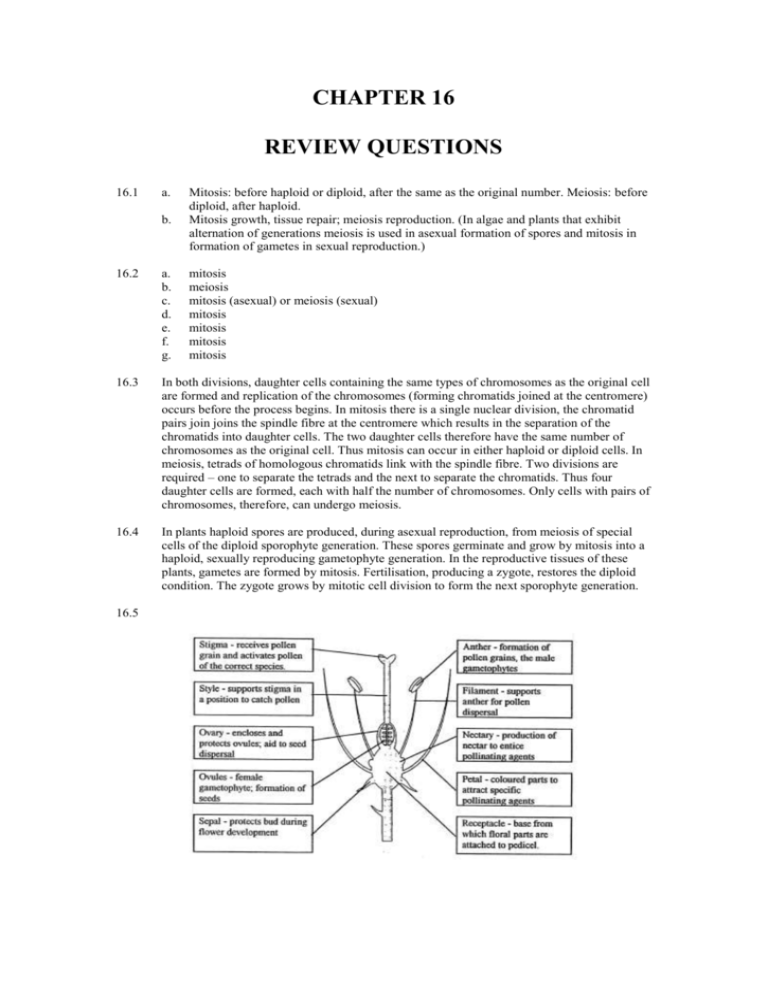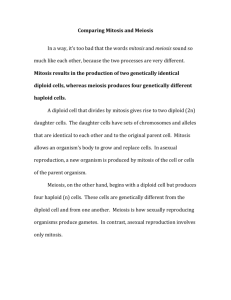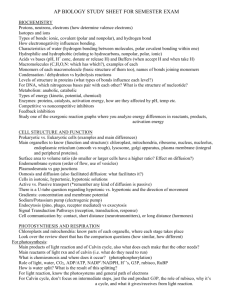Plant Reproduction Review Questions - High School Biology
advertisement

CHAPTER 16 REVIEW QUESTIONS 16.1 b. Mitosis: before haploid or diploid, after the same as the original number. Meiosis: before diploid, after haploid. Mitosis growth, tissue repair; meiosis reproduction. (In algae and plants that exhibit alternation of generations meiosis is used in asexual formation of spores and mitosis in formation of gametes in sexual reproduction.) 16.2 a. b. c. d. e. f. g. mitosis meiosis mitosis (asexual) or meiosis (sexual) mitosis mitosis mitosis mitosis 16.3 In both divisions, daughter cells containing the same types of chromosomes as the original cell are formed and replication of the chromosomes (forming chromatids joined at the centromere) occurs before the process begins. In mitosis there is a single nuclear division, the chromatid pairs join joins the spindle fibre at the centromere which results in the separation of the chromatids into daughter cells. The two daughter cells therefore have the same number of chromosomes as the original cell. Thus mitosis can occur in either haploid or diploid cells. In meiosis, tetrads of homologous chromatids link with the spindle fibre. Two divisions are required – one to separate the tetrads and the next to separate the chromatids. Thus four daughter cells are formed, each with half the number of chromosomes. Only cells with pairs of chromosomes, therefore, can undergo meiosis. 16.4 In plants haploid spores are produced, during asexual reproduction, from meiosis of special cells of the diploid sporophyte generation. These spores germinate and grow by mitosis into a haploid, sexually reproducing gametophyte generation. In the reproductive tissues of these plants, gametes are formed by mitosis. Fertilisation, producing a zygote, restores the diploid condition. The zygote grows by mitotic cell division to form the next sporophyte generation. 16.5 a. 16.6 a. b. c. d. e. The male gametophyte is the pollen grain (enclosing the male sex cell nucleus) which is dispersed to the female gametophyte (the ovule embedded within the sporophyte ovarian tissues) by wind or other pollinating agent. Thus the plant does not depend on an external source of water for transfer of the male gamete to the female gamete. Flowering plants are no longer tied to a moist environment by reproductive requirements, and so can exploit a greater range of terrestrial habitats. Decreases the randomness of wind pollination and thus increases the chance of pollen of the correct species encountering the stigma. Attracts fruit eating animals which will aid in the dispersal of seeds. Aids in the dispersal of the seeds and so reduces competition for resources between germinating seeds and the parent plant. 16.7 The specialised diploid ‘mother cell’ within the embryo sac of the ovule undergoes meiosis to form four haploid spore cells. Three of these degenerate whilst the remaining one undergoes rapid maturation. The nucleus then undergoes three successive mitotic divisions resulting in eight haploid nuclei, four at each end of the embryo sac. One nucleus from each end migrates to the centre of the embryo sac to form polar nuclei. The remaining six nuclei each become separated by cell walls. One of the cells at the micropylar end develops into the functional egg cell. 16.8 Each species of flower has pollen grains of a particular size, shape or chemical constitution. The stigma of each species will only stimulate pollen tube growth if it has the correct features. Successful pollination, resulting in the growth of a pollen tube, requires compatibility between pollen features and stigma features. 16.9 In most species the function of the sperm is to locate the egg cell and inject its nucleus into it. The growth of the zygote, therefore, is dependent upon the food reserves within the egg cell. Thus the sperm are relatively short lived, requiring only enough energy to reach the egg. The greater the number of sperm, the greater the likelihood that one will encounter an egg cell. The production of one functional cell in the female, with most of the cytoplasm (and thus energy reserves) ensures greater success for the developing embryo. 16.10 Feature Petals Nectary Pollen grains 16.11 Wind-pollinated Absent or reduced Absent Light, dry; often winged Insect-pollinated Brightly coloured Present Sticky/rough to adhere to insect 16.12 a. b. c. d. e. 8 8 24 16 16 16.13 a. b. Fruit. The pod is a dehiscent fruit. The pod dries out and this creates a mechanical force which explosively opens the pod and forcibly ejects the seeds. Any two answers from: Wind dispersal, e.g. poppy seeds, dandelion. Water dispersal, e.g. black bean, coconut. Animal dispersal, e.g. cobbler’s pegs, mulberry. It reduces competition for resources between parent plants and germinating seeds. c. d. 16.14 Underground stems, e.g. rhizomes of couch grass. Above-ground stems, e.g. strawberry runners. Modified roots, e.g. root tubers of the dahlia. Modified leaves, e.g. onion bulb. 16.15 All three are methods of artificial vegetative propagation of plants. In layering, a shoot, with a cut made between two nodes, is pegged to the ground so that the cut is in contact with the soil. This induces root formation at the cut, after which the shoot can be removed from the parent plant. Both budding and grafting involve the growth of a part of a specific variety of the species onto a hardy stock plant to ensure that the resulting plant has specific characteristics. Budding involves cutting a section from the bark of the stock plant stem and inserting and binding a bud removed from a plant with the desired features. Growth of this bud, by removal of stock plant buds, results in the main aerial part of the plant. Most of the stem of the stock plant is removed and incised to expose the cambium, and a complementary woody twig from the desired plant, similarly cut to expose the cambium, is bound in place on the stock plant stem in grafting. 16.16 Both vegetative and sexual reproduction in flowering plants ensures continuity of the species through the production of a new generation. Both involve cell division, growth and development. Although vegetative reproduction is a simpler process involving one parent and is thus more energy efficient (no production of gametophytes and specialised structures to aid pollination and dispersal of seeds) than sexual reproduction, capable of producing a large number of offspring in a short period of time, unlike sexual reproduction there is no genetic variability in the offspring (which could be a disadvantage in a changing environment or in lack of resistance to specific pathogens) or dispersal of offspring (which could lead to overcrowding and competition for resources). 16.17 Growth is the increase in dry mass of an organism or cell whereas development refers to the changes in the organism as it matures. 16.18 Cell differentiation is the process whereby a generalised cell becomes specialised for a specific function. 16.19 The intensity, quality and duration of light has a direct effect on production of chlorophyll, photosynthesis, photoperiodism and phototropism in plants. Seasonal changes have a significant effect on plant growth. Similarly water availability, nutrient supply, temperature and amount of oxygen influence plant growth. Internal factors controlled by genes or controlling gene expression, which may be species or individual specific, can also influence the growth of the organism. 16.20 A deficiency disease is a disease resulting from lack of, or inadequate supply of, an essential nutrient. Any one example from Table 16.4. 16.21 Water, oxygen and a particular temperature and illumination which is species specific. 16.22 In both types of germination there is activation of the seed embryo, involving uptake of water and oxygen and the respiration of the food reserves to provide the nutrients and energy required for embryo growth and development. Hypogeal germination involves rapid elongation of the plumule causing it to push out of the ground and leave the cotyledons in the soil. In epigeal germination there is rapid elongation of the top of the radicle causing both the plumule and cotyledons to be thrust out of the ground. 16.23 Primary growth is achieved by rapid mitotic cell division in special generalised tissues, called meristems, particularly at the apices of the stem and root and at the bases of nodes and leaves in monocots (intercalary). After production, the new cells go through a phase of elongation and then development, forming the appropriate tissues of the plant stem and root. 16.24 Secondary growth occurs in woody plants and palms, and results in an increase in stem and root diameter. It occurs in two types of lateral cambium – vascular cambium, forming new xylem and phloem, and in cork cambium that produces cork, the protective outer layer of woody plants. As the vascular cambium undergoes division it produces new xylem cells on its inner surface and new phloem cells on its outer surface. As the new xylem matures it takes over the function of the existing vessels which then become filled with plant wastes and lignin to form the hard supporting heartwood. The old phloem cells and cork are sloughed off as bark, to be replaced by new tissues. 16.25 Both primary and secondary growth increase the dry mass of the plant and involve division of undifferentiated cells, elongation and development. Primary growth occurs in all plants but secondary growth only occurs in woody plants and palms. Primary growth results in an increase in the height of the plant whereas secondary growth achieves an increase in the girth of the main stem and root of the plant. 16.26 a. b. c. A: bark – composed of cork, epidermis and phloem B: wood – composed of functional and non functional xylem C: sapwood – functional xylem D and E: heartwood of two consecutive growth seasons. Three years old. In the second year (D) the growth ring is wider and the xylem vessels larger than in the other two years, suggesting that environmental conditions (correct temperature and availability of water containing dissolved mineral salts) were conducive to a high growth rate. 16.27 Unicellular organism: receptor molecules on the surface of the membrane detect changes in the environment that are significant to the organism. This may cause changes in chemicals inside the cell (communication) which result in chemical changes which are seen as the response. Angiosperms have specialised areas which can detect specific environmental stimuli, e.g. direction and intensity of light. Hormones are released at these sites and travel by diffusion to the appropriate cells (communication) which respond by changing the rate of a chemical reaction specific to that hormone. Changes in cell chemical composition act as a stimulus for intracellular responses. A multicellular animal uses both hormonal and nervous communication. Detection of an environmental change chemically activates sense organs which transmit their information to appropriate cells for chemical response, either via hormones travelling in the blood stream or via electro-chemical changes along a series of nerve tracts. 16.28 Hormones are chemicals which regulate body functions in multicellular plants and animals. 16.29 Hormones may be made in one part of the body and travel to the target site in either a transport system or by diffusion. 16.30 Tropic movements in plants are directional growth movements under the control of hormones. Tactic movements are made by the whole organism or free part of an organism (e.g. gamete) towards or away from variations in a directional stimulus. Nastic movements are made by part of a fixed plant in response to a non-directional stimulus. 16.31 Auxins promote root growth at low concentrations, whereas cytokinin is either inactive or inhibits primary cell growth but promotes lateral root growth. Auxin promotes apical dominance and cytokinin is antagonistic to auxin with respect to apical dominance. Whilst cytokinin is not involved in abscission, this process is inhibited by auxin. 16.32 Many examples, eg.: ethene gas is used to ripen green fruit in storage containers, application of auxin to unfertilised ovaries in the production of seedless fruit and use of auxin sprays to supplement pollination. 16.33 The plant is showing a phototrophic response to light. On the side of the plant exposed to the unilateral light auxins either migrate to the shaded side or are not produced (riboflavins photoxidise the enzymes used in the production of auxin). The presence of auxins on the shaded side stimulates cell elongation just below the tip and thus the plant bends towards the light. 16.34 The statoliths accumulate in the lower part of the tissues of both the root and shoot tips. This causes an accumulation of auxin in those cells. These tissues respond differently to concentrations of auxin. In the root, high concentrations inhibit growth whereas they stimulate cell elongation in the shoot. In the normal situation, cell root growth occurs just above the tip where there is not an accumulation of auxin whereas in the shoot it occurs in the tip. 16.35 At a particular stage the levels of auxin levels in the leaf decrease and the levels of ABA increase. This stimulates the plant to withdraw chlorophyll from the leaf, to decrease protein production and begin breakdown of cell membranes. At the same time, a layer of tissue formed from the breakdown of cells at the base of the leaf, the abscission layer, is produced which seals the rest of the plant from the external environment as the dead leaf breaks from the plant. 16.36 Vernalisation is a process whereby bud-break of a deciduous plant, seed germination or flowering is inhibited unless the plant has undergone a period of cold. Since these plants originate in cold-winter areas, vernalisation ensures that the plant does not begin growth and production of flowers at an inappropriate time which would ultimately lead to its demise. 16.37 a. b. 16.38 Photoperiodism is thought to be associated with response by the plant to infra-radiation (580– 730 nm wavelength). Most plants respond to the shorter red wavelengths (580–660) whilst the far-red light wavelengths (700–730) can inhibit germination and growth. Plants absorb red light using the blue pigment phytochrome. This pigment is in two inter-convertible forms, either absorbing the optimum 660 or 730 wavelengths. Absorption of one wavelength rapidly converts it to the other form. Sunlight contains more red than far-red. The P660 is thus converted to P730 during the day and back to P660 at night. P730 stimulates hormone production that activates enzymes, some of which stimulate cell growth and others that inhibit it. In short-day plants P730 inhibits flowering whilst in long day plants P 730 stimulates flowering. The short-day plants require sufficiently long periods of darkness to convert P 730 to P660 and the long-day plants require short nights to keep most of the phytochrome in the P 730 form. The tip of the coleoptile is the area which detects light. Petunias are long-day plants which require at least ten hours of daylight before they are stimulated to flower. Chrysanthemums, on the other hand, are short-day plants, requiring at least 12 hours of uninterrupted darkness to flower.








